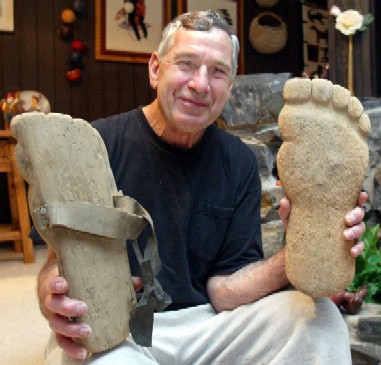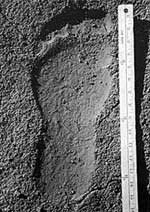
March 6, 2006


How can anyone not see that, indeed, Ray Wallace and/or his associates did use the carved wooden tools, such as this left foot fake (seen here on the right) in the series from Blue Creek Mountain, 1967 (one example track is shown here)? Blue Creek Mountain is near Bluff Creek, California, of course.
The divisive nature of this debate is obvious. Those who deny Ray Wallace was involved in actual hoaxing continue to engage in black and white thinking. I am one of the foremost supporters of the reality of Bigfoot, and you would think that because I want the "bad Wallace data" out, I am a Sasquatch skeptic and mindless debunker. Unbelievable.
Am I exaggerating? Hardly. In an email sent to me on February 17, 2006 about this Wallace debate here at Cryptomundo, John Green writes: "On this subject you should stop acting like a stubborn fool. Throughout this argument you have been able to produce no evidence, not even direct eye-witness testimony, that Wallace ever faked prints anywhere, let alone any in California or any that anyone took seriously."
People from that era are dead or beginning to die. Eyewitnesses are not a dime a dozen, but they do exist. Testimony is there, if one appreciates what is being said. These men’s stories are slowly being revealed in their obituaries, through their comments in documentaries, and what their families are remembering of the pranks they pulled as young men. There never was a large number of Wallace-fakery events, but the testimony of the tracks they left is hard to ignore. But some people still do. And a double-standard is being applied.
John Auman, 71, of Glenoma, Washington State, "who worked in the northern California forests with the late Ray Wallace says the 16-inch footprints Wallace made — using big, wooden feet strapped to his boots — weren’t a prank at all…[Auman] remembers the tracks as a theft deterrent, not just a joke…the big footprints scared off vandals who’d been coming to worksites and stealing fuel, batteries, engines — whatever wasn’t nailed down." (Source: Seattle Times, December 9, 2002.)
Jim Rakoz, 71, of Battle Ground, Washington State, died September 13, 2004. His wife, Jean Rakoz remembered "her husband and his logging friends swapping stories of enduring Washington legends. In his hometown of Toledo, he helped spread the Bigfoot myth, laying Sasquatch tracks with the Wallace brothers." (Source: The Columbian, September 18, 2004.)
Jim Rakoz was there and said he was involved in the faking, having told his relatives while he was still alive. I interviewed Rakoz’s son and brother, both of whom confirmed that Rakoz helped put down tracks with Wallace, including the intriguing detail that they would often first have the fake feet step through pig and horse manure.
Tracks found at a Wallace construction site by Steve Matthes in 1960, were identified at the time as fakes by him. Matthes says that was the reason he got out of hunting Bigfoot in 1960. And while all the Wallace fakery stories began coming out in 2002-2003, Steve M. Matthes had already mentioned these Wallace site fakes in his book, Brave and Other Stories (Carlotta, CA: Vera O. Matthes, 1988), in a chapter entitled "The Great Hoax," specifically on page 289.
You see, if the stories came from the associates of Wallace in the 1950s, they have become part of Bigfoot testimony and are believed. The road-crossing sighting on October 12, 1958, of a Bigfoot by Wallace-hired men, Ray Kerr, 43, and Leslie Breazeale, 35, is taken as gossip. The story of Bigfoot throwing a huge tire and drum down a gully, and other parts of the Bluff Creek story that have been repeated as further evidence of the Bigfoot encounter issued from, humm, Ray’s brother, more often than not.
Breaking down the "eyewitness testimonies" about where tracks were reportedly left, what 50 gallons drums were thrown down what embankments, and what Bigfoot was seen crossing the road in the headlights of a car, around Bluff Creek, in 1958, one begins to see that these witnesses turn out to be Wallace relatives, friends, and specially-hired employees. Many of these stories have passed into the almost folkloric status of Bluff Creek’s "first" Bigfoot reports as if all of them happened one day after another, when in fact they are spread out in time and space, with many Wallace compatriots connecting the dots. Ray Wallace did not have to be "on-site" for the pranks to always occur.
Think about it. Notice who says what they said they saw and when. The question, "consider the source," goes in two directions. Is there any more reason to believe all the Wallace-associated "reports" of Bigfoot around Bluff Creek in 1958, any more than there is to believe all the stories coming from Wallace associates 40 some years later that these were hoaxes? You can’t have it both ways – disbelieving Wallace and friends in 2002-2006, but believing everything they said in 1958. Why are we supposed to believe Wilbur Wallace’s reports of 50 gallon drums and huge tires being thrown around Bluff Creek in 1958, as having any substance to them? Why are we supposed to believe Ray Kerr and Bob Breazle, the conveniently just-hired Wallace employees, who said they saw a Bigfoot on a road near Bluff Creek in October 1958? But then, why are we now asked to not believe similar people, like Jim Rakoz and others, who said they were involved in the Wallace pranks?
Other older hints are ignored too.
In an Ivan Sanderson letter of February 21, 1960, to George Agogino, he recorded his doubts about Wallace. Sanderson told Agogino that after Sanderson’s True article was published he received a letter from a man who was rather convinced that something real was there: "But along the line, he now gives full details of the Mad River sighting and tracks of 1957, and mentions casually that the road there was also being built by Ray Wallace. Then I get another letter addressed to me, care of True, from a lady who owns a motel in southern Oregon, which tells me that she had another Wallace brother and two other men, whom she named, living with her all the winter of 1958-59, who used to spend much time sitting out on the porch and doing some drinking. She reported that she had overhead them (as her office was next door) having a terrific laugh over the Bigfoot business and describing in detail how Ray Wallace had made them with their, and others’, assistance by making imitation ‘feet,’ weighing them, and then being hauled up and down the slopes (by the new road) by means of the cables they used for clearing the logs out of the way.”
In one of the post-Wallace death television documentaries, old Wallace associates are shown demonstrating how a truck would pull a person, using a rope or cable, behind the moving vehicle to increase the stride when the fake prints were placed on the road, near the work site. But even John Green has mentioned, the stride was not important. It was the depth of the prints that made some people wonder. However, the depth too can be increased due to velocity and impact.
Elsewhere in the 1960 letter, Sanderson commented: “First, almost everybody who did not believe the tracks were made by an unknown living entity seemed to have the same idea. This was that Ray Wallace made them. The reason – that he was a great ‘funster.’ ”
Once again, the "let’s ignore Wallace totally" camp has chosen to ignore what has been recorded on this situation, including the "eyewitness" testimony. Why? Because it does not fit into their cosmos that they were deceived by a prankster, or that they have ignored the minor acts Wallace produced in the way of fakery.
One way that the "let’s ignore Wallace" school of thought has worked is by, more often than not, using the right fake foot when, indeed, it is the left fake foot that is a key.
Of course, if you hold up for a photographer a fake foot, it appears to be the opposite foot from the one laid down in a print. The human mind often does not do the reversal easily, unless a conscious effort is made to imagine the print being placed down into the dirt, dust, and mud. For the Wallace skeptics, it is easy to just place a similar looking but not identical print next to a fake wooden foot tool and then proclaim they don’t match.
But looking at the wooden tool that the Wallace associates used to put down the prints, as Mark A. Hall and I have noted, these are the ones that are there in the literature as the "beautiful prints" of a Bigfoot.
Sadly, the most "beautiful prints" in some books are tracks authored, most assuredly, by Ray Wallace and his friends.
Wallace fake imprints can be found in many Sasquatch/Bigfoot books. Most are labeled as Bluff Creek 1958, 1959, and 1960, or Blue Creek Mountain 1967.
About Loren Coleman
Loren Coleman is one of the world’s leading cryptozoologists, some say “the” leading living cryptozoologist. Certainly, he is acknowledged as the current living American researcher and writer who has most popularized cryptozoology in the late 20th and early 21st centuries.
Starting his fieldwork and investigations in 1960, after traveling and trekking extensively in pursuit of cryptozoological mysteries, Coleman began writing to share his experiences in 1969. An honorary member of Ivan T. Sanderson’s Society for the Investigation of the Unexplained in the 1970s, Coleman has been bestowed with similar honorary memberships of the North Idaho College Cryptozoology Club in 1983, and in subsequent years, that of the British Columbia Scientific Cryptozoology Club, CryptoSafari International, and other international organizations. He was also a Life Member and Benefactor of the International Society of Cryptozoology (now-defunct).
Loren Coleman’s daily blog, as a member of the Cryptomundo Team, served as an ongoing avenue of communication for the ever-growing body of cryptozoo news from 2005 through 2013. He returned as an infrequent contributor beginning Halloween week of 2015.
Coleman is the founder in 2003, and current director of the International Cryptozoology Museum in Portland, Maine.
Filed under Bigfoot, CryptoZoo News, Cryptozoology, Evidence, Expedition Reports, Eyewitness Accounts, Folklore, Forensic Science, Media Appearances